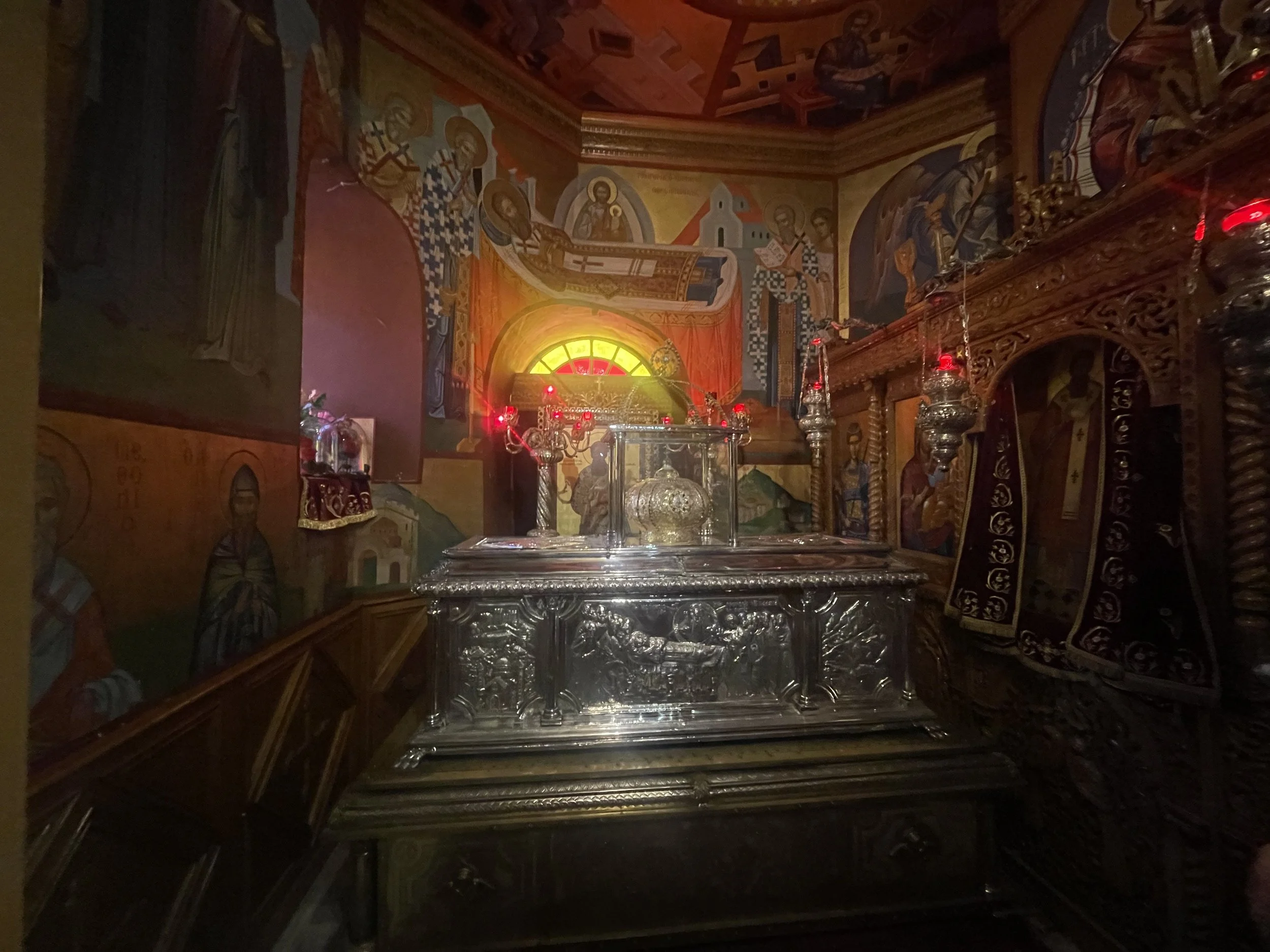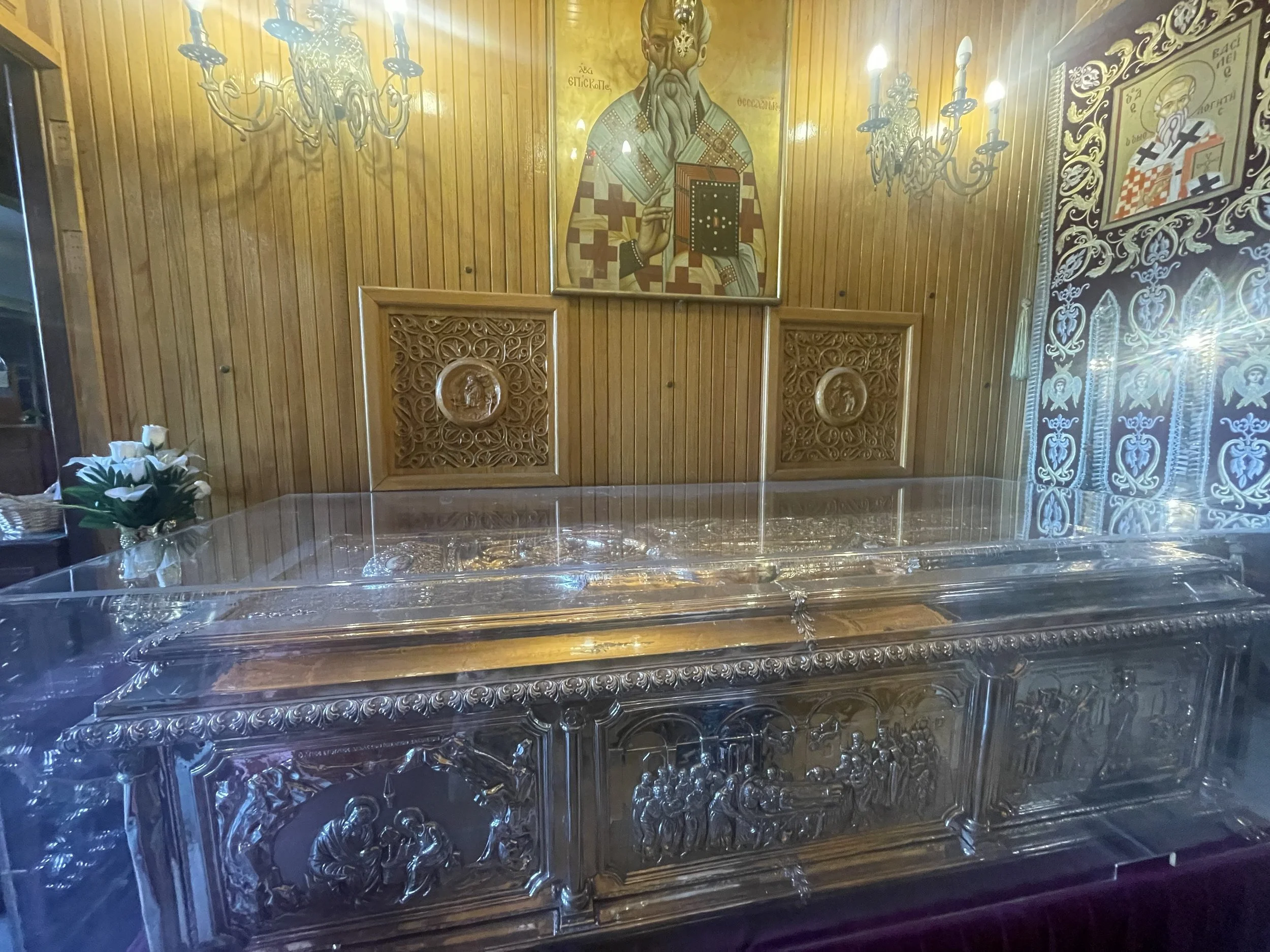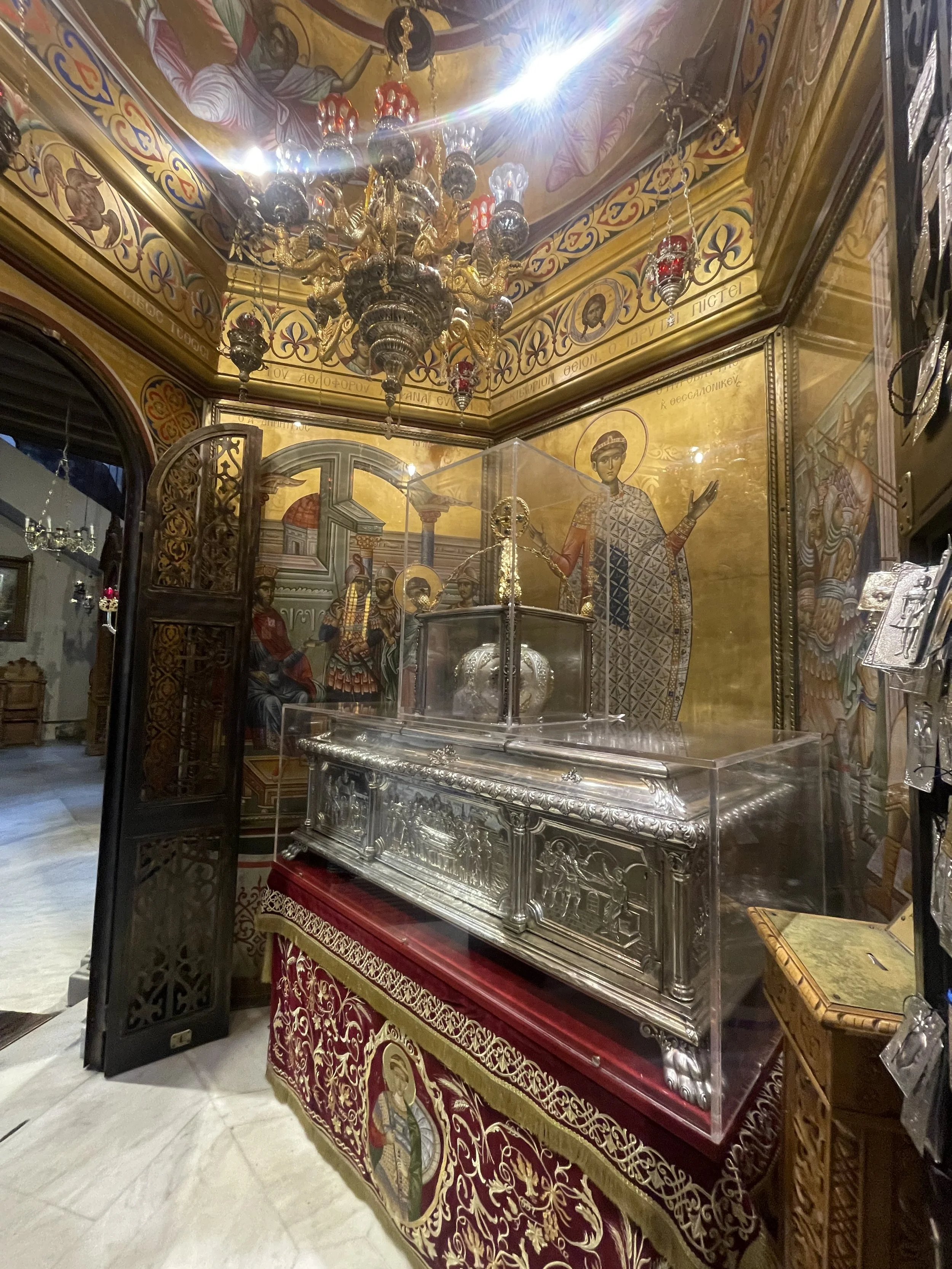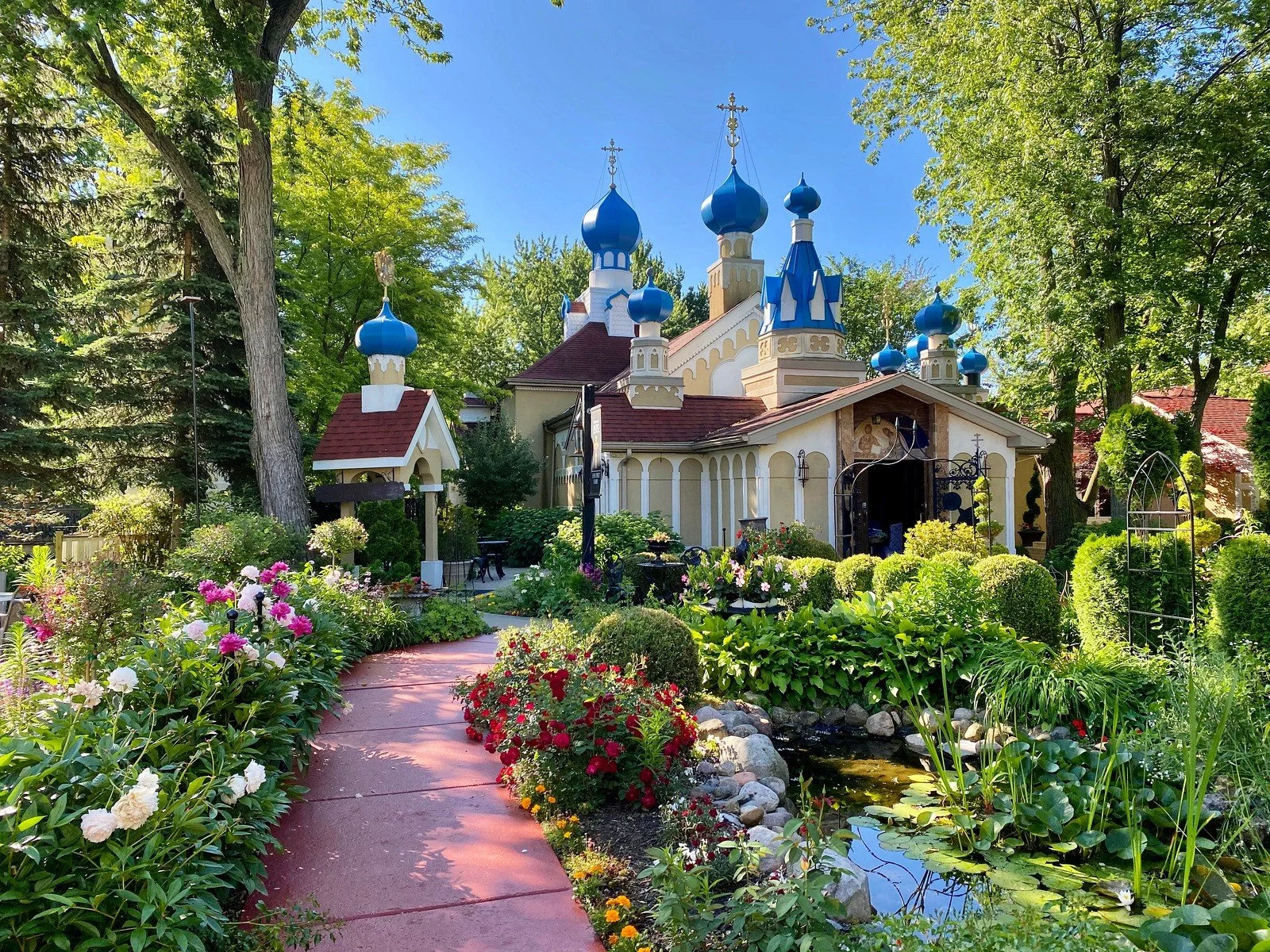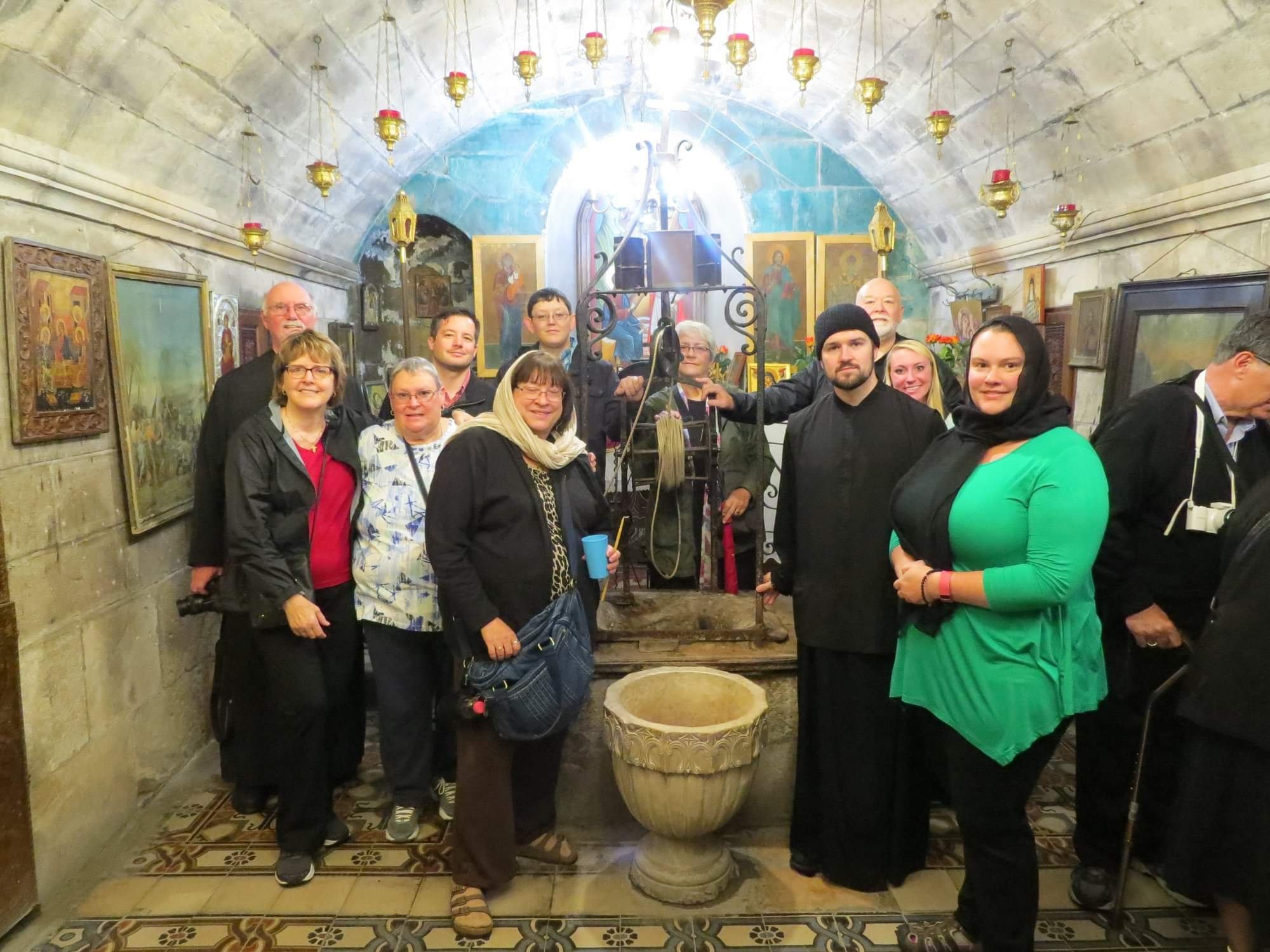Pilgrimages
Following are some short reflections from our parishioners who have been blessed to take these pilgrimages.
Mt. Athos
It’s strange to think that two years ago, I wasn’t even a catechumen in the Church and I’ve already been blessed with pilgrimages to several different monasteries. Most recently, spending a weekend on the Holy Mountain itself. I already had a great admiration and respect for monastics by now, and this trip has only amplified that.
It came as part of a trip to Greece to celebrate a wedding, I went with Father Gabriel and several other Orthodox Christians. We had to take a ferry to the mountain, along with acquire a visa, given Mount Athos’ special status as a pseudo-independent state from the country of Greece. It was quite beautiful to see the mountain and various monasteries from the water, but there was also a considerable haze from the wildfires that had been plaguing Greece.
Our first night was at Xenophontos Monastery. Here, after walking (or perhaps hiking is more accurate) to two other monasteries nearby, we attended Vespers and we ate what was one of the best meals I’ve ever had. It was only rice and peas but I thought it was incredible. I suspect the fact I did a lot of walking and hadn’t eaten since the morning had something to do with it, but I don’t think preceding circumstances diminish a food’s quality.
The second day, we visited several different monasteries by van to venerate many incredible relics, like the belt of the Theotokos, and the head of Saint Chrysostom. We also venerated many miracle working icons of the Theotokos.
I felt troubled that morning after the Divine Liturgy, just as I had for most of the previous day, so I spent most of our van ride looking out the window. I recall some of the other men were discussing some philosophical matter. I don’t think I can recall exactly what they were talking about because I found it utterly disinteresting; as I do most philosophical discussions anymore, I find the more mystical things of greater interest. Instead, I turned to the Aegean Sea and my own private prayers and contemplations.
We arrived at Simonopetra Monastery. This was, for many of us, the highlight of the trip. It’s an amazing piece of architecture; it’s seven hundred years old and was built on the edge of a cliff. This is also the place where the hand of Saint Mary Magdalene is kept. I had heard that it maintains body temperature, and now, I can personally affirm that it’s true. Other incredible relics I venerated, like the skull of Saint Andrew the First-Called, or even part of the True Cross, felt cold; but with Saint Mary Magdalene, I felt her warmth.
To our surprise, the monk present when we went to venerate the relics, Father Iakovos, was American. Without the language barrier, he was able to tell us a story of miracles that have happened at Simonopetra.
Simonopetra Monastery
Founded on Mt. Athos in the year 1368 on the Southwest side of the Holy Mountain.
We departed Simonopetra and made our way to Vatopaedi Monastery. We would be staying the night here. This monastery was very interesting because although it was a Greek church, it was originally a Russian monastery and so was constructed after the style more commonly found in the Kievan-Rus area than in Greece.
After Liturgy Sunday morning, the pilgrims were served pasta with a meat sauce, which was very surprising to us; we expected we’d always be given what the monastics ate. Father Gabriel ate with the monastics; you can imagine his dismay when we told him that we were served meat.
I previously mentioned that I was troubled and turned to my private prayers and contemplations. It’s true that, for most of the trip, I had a somewhat unsettled mind with only brief respite during church services, when venerating icons, and I also found Simonopetra particularly peaceful. Only now, several weeks after the pilgrimage, do I begin to understand what was and is happening to me.
The past pilgrimages I made to Holy Dormition Monastery, Saint Sabbas Monastery, and Saint Romanos Hermitage were so peaceful. Why was my visit to Mount Athos so different?
I was a catechumen for all previous pilgrimages. I suppose I may have been protected from certain aspects of spiritual warfare because I did not have the tools which are the Sacraments. Most commonly, Confession and Eucharist.
The Holy Mysteries heal humans, encourage them up the Divine Ladder, and put an end to all sorrows and crying. They also put demons to flight, burn them, and at the same time, drown them in the waters of their own self-inflicted misery.
Perhaps now that I am part of His Body, He desired to show me that He did not come to bring peace, but a sword.
Brother in Christ,
Ephraim
Ladies Pilgrimage to Thessaloniki
While our men were on Mt. Athos, us women had a completely life changing experience with our own little pilgrimage in Thessaloniki, Greece. You can’t go anywhere in Thessaloniki without seeing a church, and most of them were open to the public. We were able to see over a dozen churches in our short time there, as well as the bodies of 4 saints.
In the church of Agios Gregorious, we venerated the body of St. Gregory Palamas.
Next, in the Agia Sophia church (where we also had liturgy on Sunday), we venerated the body of St. Basil the Confessor of Thessaloniki.
Then was St. Demetrius of Thessaloniki, the Myrrh-Gusher. We set out our day expecting to see this saint, in fact he was the only one we anticipated getting to venerate. We also got to anoint ourselves with the myrrh that was literally gushing from him. This was in the church of Agios Demetrios. On our way out, we also got to venerate the body of St. Anysia of Thessaloniki!
Having this experience was beyond anything we excepted, and we can truly say it brought us closer to each other and to God.
Your sister in Christ,
Katherine
Holy Dormition Monastery
Seeing Only Stones: A Visit to Dormition Monastery
I was very excited to visit Dormition Monastery for the Dormition this year. It was both my husband and sons first time at a monastery. I expected to show my husband around the grounds after service. I wanted my son to get a chance to explore the children's garden. I anticipated sunshine, the smell of incense carried upon the breeze, and the shining faces of all in attendance.
However, my expectations were not met.
It rained. Not even a warm summer rain, but a cold and bitter storm. The scent of the drenched soil overpowered the light aroma of myrrh and frankincense. We, with our young son, were unprepared for the weather, resulting in us huddled together in order to avoid the ceaseless drizzle and remain warm. And it was not just us. With this being such a large pilgrimage, many young families ended up standing outside the outdoor chapel, praying for a break in the clouds.
I did not know how I would write about this experience. Believe it or not, I am under obedience to my priest to continue writing, and it was specifically requested that I recount my experience on this day to share with my parish.
In regards to this visit, I have felt that I don't have much to offer. I suppose I will just sum up the highlights of my experience.
My son woke up unusually early that morning. This being the case, we left earlier to ensure he would nap on the hour long drive. This means we were able to arrive in time for Hours, ahead of Divine Liturgy.
The church was relatively empty, and this allowed us to take in the beautiful iconography. We were able to receive a blessing from the bishop and venerate the icons. We were able to participate in the first half of Hours before my son grew restless. Having the newly acquired ability to walk, he wanted to get down and explore. Knowing my husband would appreciate this time to take in the monastery experience, I took my son outside.
I tried to show him the beautiful mosaics, the flowers, the candles, the icons that were everywhere. He decided against seeing all those beautiful things and wanted to play in the rocks. For every lovely thing he could have experienced, there was a rock he wanted to focus on. I grew tired of constantly setting him back on the path we were walking just for him to run off once more.
Fortunately, this walk allowed us to see some of my family. Both my grandma and tanti (term of endearment for older Romanian women) recognized us and came over to coo at my son. We waved to the local priests as they bustled around in preparation. We were also able to visit with my aunt, uncle and cousins, as well as my parents and sister.
By the time we found my husband in the midst of the procession to the chapel, it was crowded. My son, still wanting to explore, forced us to forgo our cramped spot under the roof for more space, exposed to the elements. At the best of times, it was drizzling. It poured at the worst. All the while, my underdressed son could not help but put every acorn and pebble in his mouth. In a moment of desperation, we fled to the car.
As we all warmed up, I expressed to my husband that I did not know if it would be worth it to stay for the rest of the service. He assured me that we should stick it out. Once drier, we ventured out into the storm once more.
Though it was miserable, everyone was generous, with both their space and umbrellas. Eventually, we were able to squeeze back in under the chapel roof, and my son fell asleep just before communion. He slept long after service had ended.
Finally, the weather began to lighten up. People grabbed their picnic baskets and opted to eat within the chapel, as opposed to sitting at the tables outside. My (rather bold) relatives opted to bring a picnic table inside.
We set the table and shared with those around us. My husband talked with a woman inquiring about Orthodoxy. My sister and cousins talked to their friends. I talked with my aunt and mother as my son scarfed down schnitzel.
It turned out to be a lovely time.
As we made our way back to the car, I felt that something was off. We had come all this way, and for what?
Sadly, I realized I had almost forgotten what we had been celebrating: the life and death of the Theotokos.
The Theotokos, who had been in the temple since she was a young girl.
The Theotokos, who had to be betrothed to St. Joseph, as she could no longer stay in the temple as she became a young woman.
The Theotokos, who faced ridicule and scrutiny, even from her own husband at first, for carrying our Lord within her womb.
The Theotokos, who gave birth in a cave, surrounded by animals.
The Theotokos, who watched her son die on the cross for the sins of the world.
The Theotokos, who had a life much harder than most of us could conceive of, yet still maintained her holiness, and was assumed into heaven.
She, better than any of us, knew how God can take struggle and turn it into something beautiful. Throughout this whole trip, my tired eyes could not see the glorious gifts God has presented us in giving us such a taxing day.
Our early-rising son allowed us to make it to the monastery in time for Hours.
In taking my son out of Hours to walk around, I not only allowed my husband to enjoy his first time at a monastery, but I was also able to spend time with my family.
By standing outside the chapel, we were able to get a glimpse of the world through our sons eyes. Not only that, but we got to witness the patience of other parents, as we all struggled together in caring for our kids in the inclement weather. We were also graced with the kindness of strangers who offered us umbrellas and places to sit.
At the end of it all, the storm passed, and the sun returned. We were blessed with the opportunity to enjoy the feast as a community, and revel in God's glory together.
And I almost missed it.
Like my stone-loving son, I kept looking at the hard patches we were trudging through, instead of the beauty all around me. Thankfully, both God and my husband served as guiding hands, leading me away from thoughts of quitting early and going home.
Think of how many wonderful things we miss simply because we choose to focus on rocks…
We do not know what we are capable of until we are tested and tried. We never realize how unprepared we are until we are caught in the rain without an umbrella. We cannot see the beauty of God around us unless we open our eyes and see that everything is good, no matter how we feel about it in the moment.
This trip was not what I expected. It was not terrible, but it was not as amazing as I wanted it to be for my family. But such is life. A life lived in obedience to God. We are called to take the good and the bad, and give glory to God for all of it. And in doing so, our eyes grow more accustomed to the beauty of this life as we grow closer to Him.
So, please, look up from the rocks every once in a while. There is much beauty to be found.
Your Sister in Christ,
Mia
St. Sabbas Monastery
I visited Saint Sabbas Monastery just a few days before Christmas (New Calendar) and, indeed, I am glad to have gone. We arrived shortly before Vespers and we were greeted at the door with candles. Walking into the Nave from the Narthex, it is impossible to not behold the icons covering every wall; particularly when the light from our candles is reflected by the golden halo of each saint depicted.
As with the hermitage I made a pilgrimage to just a few weeks prior to this visit, I was struck by the supreme quiet of this place. It was a weekday and the service was at six p.m.; one might think a metro Detroit suburb would have a good amount of activity at that time, but I cannot recall hearing a single car driving by, or a neighbor’s garage door as they returned home for the evening.
We sang a few Christmas carols at the end of Vespers which was a welcome surprise and made me glad that I accepted the offer of a candle when I walked in. After which, Archimandrite Pachomy gifted several relics he possessed to a nearby parish. Being a catechumen, I have been attempting to understand why monasteries are so important to Orthodox Christians. After all, I am a former Protestant and there is no monastic tradition in Protestantism. Furthermore, it’s strange for we Americans who often judge things based on their contribution to the economy. But for Orthodox peoples, relics are very important. During this pilgrimage, I began to understand that monasteries sometimes act as a, “relic library,” if you will. Relics of holy people and places are kept and cared for, and sometimes gifted to parishes for the laity to venerate.
We made our way to the restaurant in one of the Monastery’s other buildings for a sort of evening coffee hour. Yes, this Monastery has a restaurant on its property. We were also given small icons the abbot had obtained on his recent pilgrimage to the Holy Land. These icons were placed on the Tomb in the Holy Sepulchre.
A few of us went back into the church with the novice to take a closer look at the icons. Here, the novice told us that Archimandrite Pachomy insisted the church be built in the same fashion as the early churches. So, if I were to make a pilgrimage to the Holy Land, some of the churches I visit would look exactly the same. I was pleased to see an icon of the Royal Passion Bearers. I suppose it is not very surprising considering this is a ROCOR monastery. I am not sure what draws me to the royal family, but I am glad to see them every time I come across their icons.
It just so happened that I made this pilgrimage with the Abbot’s Godfamily. This was unbeknownst to me until we were on our way but it speaks to how tight-knit Orthodoxy in America is. The lives of someone of station often seem a mystery to us and it’s as if they are far above us smallfolk. But his Godparents (and Godsister) go to our very own parish. They are among the first people I met when I started attending Saint Mary Magdalene’s. I’ve seen pictures of him holding his Godsister as a baby. This seems to me how most often God’s Grace comes to us. Not in mighty men, astonishing deeds, or even the more conspicuous miracles, but in the love and fellowship of ordinary people.
God bless the monks of Saint Sabbas Monastery.
Brother in Christ,
Ephraim
The Hermitage of St. Romanos
Saint Romanos Hermitage is not quite what one might think of when they think of a hermit. At least for me, before Orthodoxy, hermits (or any kind of monk, really) were only a concept and so they all lived in caves or backwoods shacks, far away from the rest of humanity. Those certainly would make good, ascetical cells for a monk; but at Saint Romanos in Williamston, Michigan, they live in a house.
The trip was organized by Father Matthew of Saint Nicholas in Burton and so I and a fellow parishioner carpooled with him. We arrived and were greeted by Father Cosmas, who would be our main, “guide,” so to speak.
He spoke to us about what the Hermitage provides, mainly music, but also as a reprieve for pilgrims from our daily lives. And, of course, the primary goal of peace and repentance, both for the monks, and for everyone they pray for. That means you and I too.
The monks also make coffins for purchase. Their own coffins are already made. Indeed, the first one they made was Father Cosmas’. He preferred all their rookie mistakes be made on his coffin rather than someone else’s. Our very own priest at Saint Mary Magdalene’s, Father Gabriel, teaches in his metanoia classes that remembrance of death is very important for Orthodox Christians. These hermits seem to understand that well and keep it close to them by constructing the very coffins they will one day be placed in.
The second, and more primary goal of peace and repentance is what struck me most about this trip. This house is in a regular American neighborhood, and faces the main road. I never noticed the sound of lunch rush traffic going by, despite the road being hardly fifty feet away. The monks were all soft spoken as we read the Prayers of Thanksgiving, having made our pilgrimage the week after Thanksgiving. When we sat down for lunch, the only person permitted to speak was the person reading scripture while we ate. Such peace and quiet is rare for we who live out in the world, where even a fleeting moment of silence feels like a mistake.
We then went down to Saint James, the parish the monks attend for the Divine Liturgy. Every wall is covered in icons done by the hand of Father Cosmas’ mother, along with his assistance. It is absolutely beautiful. A personal favorite of mine is that of Saint Elizabeth the New Martyr. Father Cosmas related that they occasionally hold open houses when there is an event downtown. Many people are amazed and have never seen anything like it.
As I write this, they own their main building, along with a second house down the street which they purchased in 2021. They are also working on converting an old carriage barn into a chapel. They would like to eventually purchase the houses neighboring their original building in order to have that entire block be part of the Hermitage. This Hermitage only began in 2015 and so is very new. Nonetheless, they have begun something incredible. God willing, they will have many more years there and their expansion goals will succeed!
Love in Christ,
Ephraim
Parish Pilgrimages to the Holy Land
God-willing our next pilgrimage will be in the Fall/Winter of 2024
November 20 - November 30, 2022
Parishioners with Patriarch Theophilos III of the Holy City of Jerusalem and all Holy Land, Syria, beyond the Jordan River, Cana of Galilee, and Holy Zion.
Going to the Holy land was something that I thought would always be just a dream. November of 2022, that dream became a reality.
I went on this trip thinking it would be an amazing adventure to visit another country and see some of the places spoke of in the Bible. Our first day, I quickly realized that it was much more.
The emotions and grace that I felt were overwhelming at times. There were several occasions that I couldn’t breathe because it was so powerful. I’ve heard people say that they felt Gods presence, however, I had never experienced this until this trip. It was something you can not explain to someone until they experience it themselves.
The friendships and bonds that were made on this trip will last a lifetime.
One of my most memorable moments was the day we went to Mt. Tabor. I have a friend who was born with spina bifida and has been confined to a wheelchair for several years and has no feeling in her legs. She has undergone several surgeries to try and get some relief and nothing has ever worked. She had recently had another surgery just before our trip and I prayed for her and lit candles everywhere we went. When we left Mt. Tabor, I received a message from her and she told me that when she woke up that morning, she not only had some feeling in her legs, she could also move her feet! This, took my breath away, as I knew that God was answering our prayers! I told her where I had just been and prayed for her and she became very emotional and said she knew it must be Gods work. To this day she tells everyone this story.
God willing, we will be able to visit again and experience the power and grace of the Holy Land. I encourage everyone to never let this opportunity to pass by.
Your sister in Christ,
Justina
November 20-November 28, 2017
Parishioners drinking from Jacob’s Well where Christ met the Samaritan Woman, St. Photini - our Altar saint.
Our trip to the Holy Land was so blessed in so many ways. Being with Father Gabriel, Father Pachomy, our wonderful SMM group, the great group from CA who joined us, and especially, meeting wonderful Archbishop Damascenos of Jaffa and visiting his beautiful church, St. Michael the Archangel Cathedral, on the Mediterranean Sea. Attached to it is a smaller church on the site of the home of St. Tabitha, who Jesus raised from the dead. How awesome to stand in the place of that miracle.
Our most favorite place was the Church of the Holy Sepulchre. The sense of holiness and awe in this beautiful place kept drawing us back, and being in the cave where our Lord was buried and resurrected was a gift beyond words.
And the blessings kept coming, day after day - Jacob's Well, the Mount of Olives, the Church of the Annunciation, a boat ride on the Sea of Galilee, the Church of the Apostles, a private audience with Patriarch Theophilus in Jerusalem, the Convent in Magdala, the tomb of the Theotokos, the Mount of Transfiguration, the Monastery of St. Stephen on the site of his martyrdom, and the tomb of Lazarus. The Church of the Nativity was a special blessing, being able to kneel down and kiss the place of our Lord's birth, and to see and hear our Father Gabriel reading the Holy Gospel.
We visited so many other beautiful holy sites, too many to list, and would love to visit all of them again!
With Love in Christ,
Susanna



